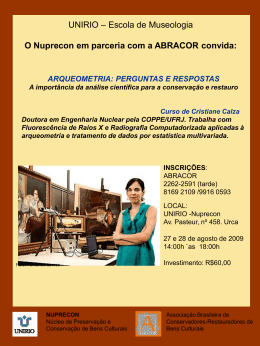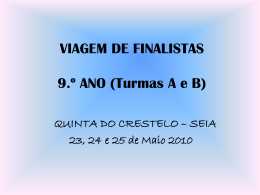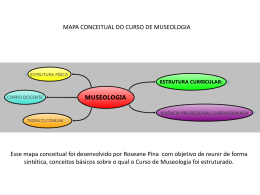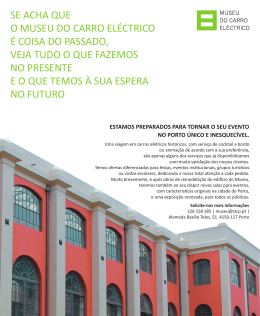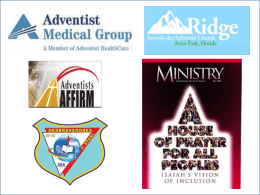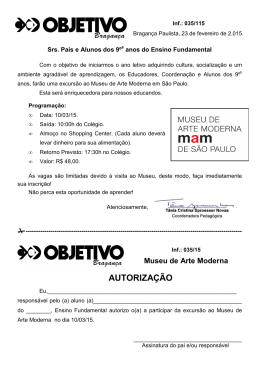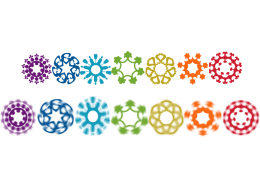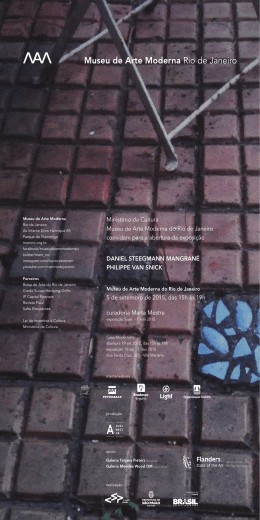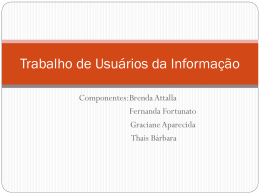CONHEÇA OS PRIMEIROS MESTRES EM MUSEOLOGIA E PATRIMÔNIO 1ª. TURMA DO PPG-PMUS 2006 / 2008 BRUNO CÉSAR BRULON SOARES Dissertação defendida em 30 de março de 2008 Banca Examinadora: Prof. Dr. Márcio Ferreira Rangel (DEMU/IPHAN) Profa. Dra. Heloisa Helena Gonçalves da Costa (PPG-PMUS) Profa. Dra. Tereza Scheiner (orientadora) Prof. Dr. Márcio d’Olne Campos (co-orientador) Currículo Lattes BRULON SOARES, Bruno C. Quando o Museu abre portas e janelas. O reencontro com o humano no Museu contemporâneo. 2008. Dissertação (Mestrado) – Programa de Pós-Graduação em Museologia e Patrimônio, UNIRIO/MAST, Rio de Janeiro, 2008. 162 p. Orientador: Tereza Cristina Moletta Scheiner. Coorientador: Márcio D’Olne Campos. RESUMO Análise das mudanças ocorridas na concepção de Museu e das novas experiências desenvolvidas no decorrer do século XX, como o movimento intitulado Nova Museologia. É no bojo destas mudanças que a Museologia descobre no Museu fenômeno o objeto que dela faz um campo disciplinar entre as ciências contemporâneas. Considerando algumas das manifestações do Museu, tais como os museus locais, os museus de vizinhança, os ecomuseus, os Children’s Museums e os museus exploratórios – todos extremamente comprometidos com a experiência –, bem como o movimento ideológico conhecido como Nova Museologia, torna-se possível perceber que a experiência é e sempre foi o legítimo e verdadeiro objeto do Museu. A experiência sobre o território no Museu é analisada no âmbito das relações humanas que nele sucedem: o Museu reconcilia o humano com o ambiente integral. É através da memória viva das comunidades que o Museu, ao tentar refletir semioticamente o que o rodeia, descobre o poder da identidade, que sempre constituiu a sua essência. Finalmente, a experiência do intangível também marca este Museu renovado. Como exemplo será analisado o terreiro de candomblé musealizado em Salvador, Bahia, Îlê Opô Afonjá. O Museu que abre portas e janelas se vê cada vez mais permeado pelo humano, admitindo que o seu maior objeto está na experiência do real. Palavras-chave: Museu. Museologia. Nova Museologia. Museu comunitário. Novo Museu. BRULON SOARES, Bruno C. When the Museum opens doors and windows. The encounter with the humane in the contemporary museum. 2008. Dissertation (Master) – Graduate Program in Museology and Heritage, UNIRIO/MAST, Rio de Janeiro, 2008. 162 p. Supervisors: Teresa Cristina Moletta Scheiner, Márcio D’Olne Campos. ABSTRACT Analysis on the changes in the conception of Museum and of the experiences developed throughout the 20th century, such as the movement of New Museology. It is in the context of these changes that Museology discovers, in the phenomenon Museum, the object which constitutes it as a disciplinary field, among the contemporary sciences. Considering some of the modern manifestations of the Museum such as local museums, neighborhood museums, ecomuseums, children’s museums and exploratory museums – all of them thoroughly committed to experience –, as well as the ideological movement known as New Museology, it is possible to perceive that experience is, and has always been, the legitimate and true object of the Museum. The experience with the territory within the Museum is analyzed through the interfaces offered by human relationships: the Museum reconciles the human being with the total environment. Through the living memory of communities, the Museum, trying to reflect such environment in a semiotic manner, discovers the power of identity which defines its essence. The intangible experience also impregnates this renewed Museum. It is herein presented through the analysis of the musealized terreiro of Candomblé in Salvador, Bahia - Îlê Opô Afonjá. The Museum that opens doors and windows can be perceived in its connection with the human interface, letting show that its main object is the experience of reality. Keywords: Museum. Museology. New Museology. Community Museum. New Museum. LUCIANA MENEZES DE CARVALHO Dissertação defendida em 11 de abril de 2008 Banca Examinadora: Profa. Dra. Suely de Moraes Ceravolo (UFBA) Profa. Dra. Moema de Rezende Vergara (PPG-PMUS) Profa. Dra. Tereza Scheiner (orientadora) Prof. Dr. Marcos Luiz Cavalcanti de Miranda (co-orientador) Currículo Lattes CARVALHO, Luciana Menezes de. Em direção à Museologia latino-americana: o papel do ICOFOM LAM no fortalecimento da Museologia como campo disciplinar. 2008. Dissertação (Mestrado) – Programa de PósGraduação em Museologia e Patrimônio, UNIRIO/MAST, Rio de Janeiro, 2008. 107 p. Orientador: Tereza Cristina Moletta Scheiner. Co-orientador: Marcos Luiz Cavalcanti de Miranda. RESUMO Análise das relações entre a Museologia e seu objeto de estudo, o fenômeno Museu, na América Latina, a partir da produção do Subcomitê Regional do ICOFOM para a América Latina e Caribe - ICOFOM LAM. Para entender esta relação, faz-se uma breve apresentação das questões que envolvem a construção de uma ciência, na interface entre os paradigmas modernos e pós-modernos (interface onde a Museologia inicia seus “primeiros passos”). Em seguida apresenta-se os conceitos e as definições de campo de Bourdieu e de Foucault e de conhecimento de Miranda, para explicar o processo de construção e consolidação da Museologia como campo do conhecimento, culminando com a criação do Comitê Internacional de Museologia – ICOFOM, do Conselho Internacional de Museus – ICOM. A dissertação propõe uma ‘revolução’ em vários aspectos: primeiramente, ao refletir sobre o processo de configuração do que se denomina América Latina, a autora apropria-se do conceito de “suleação” (orientação usando como ponto de referência o Sul geográfico) – apresentado por Campos – para justificar a importância de uma Museologia voltada para as necessidades da Região; a seguir, identifica os “movimentos” em prol da “desnorteação” e de uma possível “suleação” da América Latina - mudanças no modo de pensar as questões pertinentes à realidade de nossa Região; finalmente, observa o Museu neste espaço. Considerando o processo reflexivo sobre a consolidação da Museologia, analisa o desenvolvimento da Museologia latino-americana, a partir da criação do Subcomitê Regional do ICOFOM para a América Latina e Caribe - ICOFOM LAM. O trabalho inclui uma análise dos documentos finais de cada encontro deste grupo e de artigos publicados pelos autores e teóricos do ICOFOM LAM. Palavras-chave: Museu. Museologia. América Latina. ICOM. ICOFOM LAM. CARVALHO, Luciana Menezes de. Towards a Latin-American Museology: the role of ICOFOM LAM in the strenghtening of Museology as a disciplinary field. 2008. Dissertation (Master) - Graduate Program in Museology and Heritage, UNIRIO/MAST, Rio de Janeiro, 2008. 107 p. Supervisors: Tereza Cristina Moletta Scheiner, Marcos Luiz Cavalcanti de Miranda. ABSTRACT Analysis of the relationships between Museology and its main object of study, the Museum as phenomenon, through the theoretical production of Latin American specialists, related to ICOFOM LAM – the Regional Subcommittee of ICOFOM for Latin America and the Caribbean. To understand such relationships, a brief approach is made on discussions about the rise and development of a science, in the crossroads between modern and post-modern paradigms. This is followed by a short discussion on the concepts and definitions of field, in Bourdieu and Foucault, and of knowledge, in Miranda, which help understanding the process of development and consolidation of Museology as a field of knowledge. In such process, the importance of the International Committee on Museology – ICOFOM is emphasized. A multifaceted ‘revolution’ is then proposed: first, through the adoption of the concept of ‘Southerization’ (orientation using as reference point the geographic South) – presented by Campos – in what refers to Latin America, to justify the importance of a Museology dedicated to the needs of the Region; and then, by identifying the tendencies of a possible ‘Southerization’ of thought. This includes a shift in the ways through which Latin American realities are perceived and studied. Observing the Museum under such light, and considering the theoretical movements that lead to the consolidation of Museology, the dissertation approaches the development of Latin American Museology and the importance of the Regional Subcommittee of ICOFOM for Latin America and the Caribbean – ICOFOM LAM. The work presents an analysis of the final documents of each annual meeting of this group, as well as of articles published by the theorists of ICOFOM LAM. Keywords: Museum. Museology. Latin America. ICOM. ICOFOM LAM. ROBERTA NOBRE DA CÂMARA Dissertação defendida em 11 de abril de 2008 Banca Examinadora: Prof. Dr. Márcio Ferreira Rangel (DEMU/IPHAN) Prof. Dr. Márcio d’Olne Campos (PPG-PMUS) Profa. Dra. Magali Romero Sá (co-orientadora / FIOCRUZ) Prof. Dr. Marcus Granato (orientador) Currículo Lattes CÂMARA, Roberta Nobre da. A patrimonialização de material genético brasileiro: o estudo de caso da coleção de fungos filamentosos do Instituto Oswaldo Cruz. 2008. Dissertação (Mestrado) – Programa de Pós-Graduação em Museologia e Patrimônio, UNIRIO/MAST, Rio de Janeiro, 2008. 115p. Orientadores: Marcus Granato e Magali Romero Sá. RESUMO O presente estudo tem por objetivo apresentar e discutir o processo de patrimonialização de material genético brasileiro, utilizando como principal referência a legislação de salvaguarda relacionada. Como estudo de caso, é apresentado o histórico da Coleção de Fungos Filamentosos da Fundação Oswaldo Cruz, FIOCRUZ, uma coleção viva, iniciada em 1922 e fiel depositária de patrimônio genético nacional, e analisada a real proteção dessa coleção, de acordo com os referenciais dos estudos patrimoniais. Ao final da dissertação, são discutidas as possibilidades de divulgação dessa coleção, sobretudo em museus de ciência, para que esse patrimônio seja valorizado e apreendido. Os estudos realizados permitem concluir que, na forma como compreendemos a proteção do patrimônio, as coleções científicas que não estão tombadas não se encontram protegidas de forma apropriada para usufruto de gerações futuras. Palavras chave: PPG-PMUS. Museologia. Patrimônio. Patrimônio genético. Coleções científicas. Museus de ciência. CÂMARA, Roberta Nobre da. Studies on the process of listing Brazillian genetic matter as heritage: the case study of the filamentous fungi collection at Instituto Oswaldo Cruz. 2008. Dissertation (Master). Graduate Program in Museology and Heritage, UNIRIO/MAST, Rio de Janeiro, 2008. 115p. Supervisors: Marcus Granato, Magali Romero Sá. ABSTRACT The aim of this study is to discuss the process of having Brazilian genetic material listed as heritage, using the legislation pertaining to the subject as the main source of reference. A case study is presented of the history of the collection of filamentous fungi at Fundação Oswaldo Cruz (Fiocruz), a live collection which was begun in 1922 as a repository of Brazilian genetic heritage. The collection’s actual state of protection is analyzed according to the literature from heritage studies. At the end, a discussion is presented of how this collection could be divulged, especially in science museums, to enhance its value and meaning. Based on our understanding of heritage protection, the studies conducted lead to the conclusion that when scientific collections are not listed, they fail to enjoy the protection needed for them to be passed on to future generations. Keywords: PPG-PMUS. Museology. Heritage. Genetic heritage. Scientific collections. Science museums. ANAILDO BERNARDO BARAÇAL Dissertação defendida em 07 de maio de 2008 Banca Examinadora: Profa. Dra. Maria Nélida Gonzalez de Gómez (IBICT) Prof. Dr. José Mauro Matheus Loureiro (PPG-PMUS) Profa. Dra. Tereza Scheiner (orientadora) Currículo Lattes BARAÇAL, Anaildo Bernardo. O objeto da museologia: a via conceitual aberta por Zbynek Zbyslav Stránský. 2008. Dissertação (Mestrado) – Programa de Pós-Graduação em Museologia e Patrimônio, UNIRIO/MAST, Rio de Janeiro, 2008. 129 p. Orientador: Prof. Dra. Tereza Cristina Moletta Scheiner. RESUMO Para a Museologia, como para a sistemática do conhecimento, seja filosófico, seja científico, é necessário que se defina o objeto a ser estudado. Nesse âmbito, a especificação do objeto na contribuição do museólogo checo Zbynek Zbyslav Stránský (1926), ocorre já em 1965, quando enuncia que o objeto não é o Museu, e que a Museologia se constituía como disciplina científica. Parte de seu pensamento é contrastada com a do museólogo alemão Klaus Schreiner e da filósofa eslovaca Anna Gregorová, em 1980, e considerada na exposição O caminho do museu, de 1971, em que sua teoria se apresenta na linguagem museística. E atinge-se o cume de seu edifício conceitual na análise do capítulo em que trata da Metamuseologia, em sua obra Archeologie a muzeologie, de 2005. Neste caso, se recorreu ao diálogo com parcela da obra Le musée virtuel, de Bernard Deloche, de 2001. O recurso a autores para efeito de contraste, atestando ou refutando considerações de Stránský, propicia e favorece apoio ou base de questionamento para as proposições teóricas do museólogo checo. Stránský tem como referencial a Gnoseologia, em que sujeito e objeto são termos fundamentais. O sujeito cognoscente subjaz ontológica ou onticamente, enquanto que o objeto carece de definição. A partir desta e de outras considerações filosóficas, Stránský atinge a sua afirmação da Museologia científica, que instaura a realidade da sua construção enquanto conhecimento. Além da precisão do objeto, outros critérios de identificação científica são a metodologia e a terminologia. A riqueza da terminologia cunhada por Stránský – expressa em termos na complexidade conceptual e lingüística de seu idioma natal, o checo - proporciona um debate angular que alimenta o panorama museológico. A questão sobre o objeto da Museologia, complexa já desde 1980, com discussão patrocinada pelo Comitê para a Museologia do Conselho Internacional de Museus, ICOFOM, ainda persiste. Procurou-se nesta dissertação não a resposta ou a geração de uma alternativa conceitual. Trata-se de uma arqueologia, uma busca por fragmentos estimuladores da crítica e da criatividade analítica. A perspectiva metodológica se pretendeu filosófica, recorrendo-se a uma constante e infinita inquirição, que não se pode esgotar, quer na capacidade do acadêmico, quer nos limites do próprio conhecimento. Trata-se de uma nova série de perguntas sobre a natureza da Museologia na sua relação metafísica com o ser e, assim, distanciada das considerações fenomenológicas. Desdobra-se, de fato, na discussão em nível da Metamuseologia, enquanto teoria da Museologia, significando um exercício de contribuição à reflexão teórica do campo. Palavras-chave: Museologia. Teoria da Museologia. Metamuseologia. Stránský. Ciência. Filosofia. BARAÇAL, Anaildo Bernardo. The object of Museology: the conceptual pathway created by Zbynek Zbyslav Stránský. 2008. Dissertation (Master). Graduate Program in Museology and Heritage, UNIRIO/MAST, Rio de Janeiro, 2008. 129 p. Supervisor: Teresa Cristina Moletta Scheiner. ABSTRACT For Museology, as for the knowledge systematic, either philosophic or scientific, is necessary to define the object to be studied. In this field the designation of the object in the contribution of the museologist Zbynek Zbyslav Stránský (1926) takes place in 1965, when he proclaims that Museum is not the object of Museology, and that Museology constitutes a scientific discipline. Part of Stránský’s ideas can be contrasted with the German museologist Klaus Schreiner and the Slovak philosopher Anna Gregorová, in 1980, and it was considered in the exhibition The museum way, in 1971, when his theory presents itself in the museistic language. And it reaches its conceptual climax in the analyses of the chapter about Metamuseology, in his book Archeologie a Muzeologie, 2005. In this case, it was retraced the dialogue with a fragment of Bernard Deloche’s work Le musée virtuel, from 2001. The use of other authors that contrast, agreeing or disagreeing with Stránský’s considerations, favored questioning about the theoretical propositions of the Czech museologist. Stránský’s referential is Gnoseology, in which the subject and object are fundamental terms. The cognition’s subject is submitted ontologically and ontically, while the object lacks definition. From this and others philosophical considerations, Stránský reaches his scientific affirmation of Museology, which establishes the reality of his constructions as knowledge. Besides the object precision, other criteria of scientific identification are methodology and terminology. The richness of terminology coined by Stránský expressed in the conceptual and linguistic complexity of his mother’s tongue, Czech - provides an angular debate that feeds museological panorama. The question about Museology object, complex since 1980, with discussions supported by the International Council of Museums Committee for Museology, ICOFOM, still exists. We tried in this dissertation not to answer or to create a conceptual alternative. It’s about an archeology, a search for stimulations fragments of criticism and analytical creativity. The methodological perspective was intended to be philosophical, retracing to a constant and infinite inquire, which cannot be extinguished, either in the academic capacity, or in the limits of knowledge itself. It’s about the formulation of new questions series concerned to the nature of Museology in its metaphysics relation with the being and, therefore, distanced of the phenomenological considerations. It folds itself, indeed, in the discussion about Metamuseology, as Museology’s theory, meaning an exercise of contribution to the theoretical reflection of the realm. Keywords: Museology. Museology Theory. Metamuseology. Stránský. Science. Philosophy. LUCIA HELENA DOS SANTOS TORRES Dissertação defendida em 30 de junho de 2008 Banca Examinadora: Prof. Dr. Nireu Cavalcanti (UERJ) Prof. Dr. Luiz Carlos Borges (PPG-PMUS) Profa. Dra. Sonia Gomes Pereira (co-orientadora – EBA/UFRJ) Prof. Dr. Nilson Alves de Moraes (orientador) Currículo Lattes TORRES, Lucia Helena dos Santos. Espaços em Processo de Representação: Praça Floriano Peixoto e Ilha dos Museus. 2008. Dissertação (Mestrado) – Programa de Pós-Graduação em Museologia e Patrimônio, UNIRIO/MAST, Rio de Janeiro, 2008. 141 p. Orientadores: Nilson Moraes e Sonia Gomes Pereira. RESUMO Esta dissertação tem como foco de discussão a representação da cultura na cidade em dois centros urbanos: Praça Floriano Peixoto, na cidade do Rio de Janeiro e Ilha dos Museus, na cidade de Berlim. Através da análise de como esses centros se configuram como representativos da idéia de nação em cada uma das cidades; ressalta-se que tais centralidades têm uma mesma estrutura de pensamento e de intervenção na cidade, resultante de um modelo intelectual que é tradição desde o século XVIII e que tanto a Praça Floriano Peixoto, no momento da consolidação da República e a Ilha dos Museus, no processo de unificação alemã, fazem parte desta tradição. Palavras-chave: Centros Urbanos. Representação. Patrimônio. Ilha dos Museus. Praça Floriano Peixoto Torres, Lucia Helena dos Santos. Spaces in process of representation: Floriano Peixoto Square and Island of Museums. 2008. Dissertation (Master). Graduate Program in Museology and Heritage, UNIRIO/MAST, Rio de Janeiro, 2008. 141p. Supervisors: Nilson Alves de Moraes, Sonia Gomes Pereira. ABSTRACT This dissertation is focused on two urban centers: Praça Floriano Peixoto, in Rio de Janeiro, Brazil and Museuminsel, in Berlin, Germany. It approaches a discussion on how they represent the culture of their cities. Through the analysis on how those centers figure as icons of the idea of Nation in each city, it is pointed out that such centralities bear the same way of thinking in the city, as a result of an intellectual pattern th which is the tradition since the 18 century; and that not only Praça Floriano Peixoto at the moment of the Republic consolidation in Brazil, but also Museumsinsel in Germany´s Unification process, are parts of this tradition. Keywords: Urban Centers. Representation. Heritage. Museuminsel. Praça Floriano Peixoto. LUIZ CÉSAR DOS SANTOS BAÍA Dissertação defendida em 04 de julho de 2008 Banca Examinadora: Profa. Dra. Myriam Sepúlveda dos Santos (UERJ) Prof. Dr. José Mauro Matheus Loureiro (PPG-PMUS) Prof. Dr. Nilson Alves de Moraes (orientador) Currículo Lattes BAIA, Luiz César dos Santos. Sala do Artista Popular: Tradição, Identidade e Mercado. 2008. Dissertação (Mestrado) – Programa de Pós-Graduação em Museologia e Patrimônio, UNIRIO/MAST, Rio de Janeiro, 2008. 105p. Orientador: Prof. Dr. Nilson Alves de Moraes. RESUMO Estudamos o contexto e o discurso produzido pela Sala do Artista Popular – SAP – do Centro Nacional de Folclore e Cultura e o processo de produção de sentidos que embasam os quadros de identidade do "artista popular" no universo sócio-cultural contemporâneo brasileiro. Tal proposta apontou para a reflexão acerca da categoria "arte popular" em sua vinculação essencial com os conceitos de Tradição, Identidade e Mercado. Analisamos os diferentes processos e estratégias expositivas da "SAP", indagando sobre as lógicas subjacentes às suas exposições e as perspectivas mercadológicas dessa produção artística que envolve uma produção oriunda de regiões culturalmente diversificadas. Todas essas perspectivas tornam a SAP um dos espaços empíricos institucionais de particular importância para observação e análise das demandas, transformações, conflitos e tensões que envolvem as perspectivas materiais e simbólicas do artista e da "arte popular" no Brasil. Pensamos a SAP como uma instituição da cultura e a cultura como processo e um modo de compreensão e fazer das classes populares buscando compreender as relações estabelecidas entre a construção de identidades e as possibilidades de mudança social. Configurada como espaço para difusão da arte popular, a SAP traz ao público objetos que, por seu significado simbólico, tecnologia de confecção ou matéria-prima empregada, são testemunhos do viver e fazer das camadas populares. Suas atividades institucionais somadas ao desempenho de seus profissionais instauram a necessidade de uma reflexão sobre o significado dos diferentes deslocamentos de obras e artistas, os impactos nos contextos sócio-culturais em que habitam e as influências trazidas pelos processos de comercialização e musealização de tais produções culturais. A produção artística separada de seu contexto originário permite ser vista e sentida de modos diferenciados. As obras de "arte popular" são inseridas em uma nova perspectiva de legitimação, valores institucionais e de mercado que não era prevista e/ou percebida inicialmente por muito de seus autores e por agentes sociais identificados com o objeto de estudo. A inserção destes artistas populares num mercado de massas não significa sua incorporação à "indústria cultural", mas a sua inserção num mercado capitalista periférico que atribui prestígio ao produtor, divulga sua obra e produz condições de vida para manter sua produção. A dissertação foi teórica e metodologicamente inspirada nas idéias de Gramsci. Utilizamos bibliografia recorrente, documentos institucionais e parte de um acervo que reunimos ao longo de dez anos de trabalho na instituição. Palavras-chave: Museologia, Patrimônio, Arte Popular, Identidade, Tradição e Mercado. BAIA, Luiz César dos Santos. Gallery of the Popular Artist: tradition, identity, market. 2008. Dissertation (Master). Graduate Program in Museology and Heritage, UNIRIO/MAST, Rio de Janeiro, 2008. 105p. Supervisor: Nilson Alves de Moraes. ABSTRACT The dissertation approaches the context and the discourse produced by the Gallery of the Popular Artist (Sala do Artista Popular – SAP) at the National Center of Folklore and Culture (Centro Nacional de Folclore e Cultura), as well as the process of production of sense that lies at the base of the identity frameworks which define the ‘popular artist’, in the contemporary Brazilian socio-cultural universe. The proposal includes a reflection about the category ‘popular art’, in its essential relationship with the concepts of tradition, identity and market. In analyzing the different procedures and strategies of exhibition at SAP, we have put under quest the different logics which lie behind the exhibitions, as well as the market perspectives of the artistic production – which involves a production originated in culturally diversified regions. All such perspectives turn SAP into one of the empiric institutional spaces of key importance for observation and analysis of the demands, transformation, conflicts and tensions which involve material and symbolic perspectives of the artists and of ‘popular art’ in Brazil. We think SAP as a cultural institution, and culture as a process and a way of understanding the know-how of popular classes, aiming at understanding the relationships established between the constitution of identities and the possibilities of social change. Created as a space for the diffusion of popular art, SAP brings to the public objects which, by their symbolic meaning, technology or material features, become testimonies of the living and cultural processes of the popular strata. Their institutional activities and the performance of their professionals create the necessity of a reflection over the significance of the different displacements of works and of artists, their impact into the socio-cultural contexts where they live and the influences brought by the processes of commercialization and musealization of those cultural products. The artistic production, separated from its original context, may be seen and felt in different ways. The ‘popular artworks’ are part of a new perspective of legitimacy of institutional and market values, not originally expected and/or perceived by many of their authors, or by social agents identified with this object of study. The insertion of the popular artists in the mass market does not signify their incorporation to the “cultural industries”, but their insertion in a capitalist peripheral market, which attributes prestige to the producer, diffuses their artwork and produces living conditions to maintain their production. The dissertation has been inspired, in method and theory, in the ideas of Gramsci. We have made use of recurrent bibliography, institutional documents and of part of a collection organized throughout ten years of work in the institution. Keywords: Museology. Heritage. Popular Art. Identity. Tradition and market. ELISA GUIMARÃES ENNES Dissertação defendida em 14 de julho de 2008 Banca Examinadora: Profa. Dra. Rosane Maria Rocha de Carvalho (UERJ) Profa. Dra. Priscila de Siqueira Kuperman (PPG-PMUS) Prof. Dr. José da Silva Dias (orientador) Currículo Lattes ENNES, Elisa Guimarães. Espaço Construído: o Museu e suas exposições. 2008. Dissertação (Mestrado) – Programa de Pós-Graduação em Museologia e Patrimônio, UNIRIO/MAST, Rio de Janeiro, 2008. 195 p. Orientador: José da Silva Dias. RESUMO A Dissertação observa a museografia de exposições através de seus recursos e sua função comunicacional. Elabora reflexões sobre o significado dos Museus e seu papel diante das novas técnicas de informação e meios de comunicação. Através de estudos de caso faz uma análise das aplicações dos elementos visuais e do design geral das exposições e sua interação com o conteúdo proposto. Palavras Chave: Museu. Exposição. Linguagens da exposição. Comunicação ENNES, Elisa Guimarães. Created Space: museums and their exhibitions. 2008. Dissertation (Master). Graduate Program in Museology and Heritage, UNIRIO/MAST, Rio de Janeiro, 2008. 195 p. Supervisor: José da Silva Dias. ABSTRACT Analysis of the museographical development of exhibitions, through their resources and communicational function. Considers the meaning and significance of museums and their importance, under new information technologies and communication media. Based on case analysis, an approach is made of the applications of visual elements, issues related to the exhibition’s general design and their interaction with the contents considered. Key Words: Museum. Exhibition. Language of exhibitions. Communication. TATIANA GONÇALVES MARTINS Dissertação defendida em 18 de julho de 2008 Banca Examinadora: Profa. Dra. Rosane Maria Rocha de Carvalho (UERJ) Profa. Dra. Diana Farjalla Correia Lima (PPG-PMUS) Profa. Dra. Tereza Scheiner (orientadora) Currículo Lattes MARTINS, Tatiana Gonçalves. O Museu como Vereda Fértil: A Museologia no Museu de Arte Contemporânea. 2008. Dissertação (Mestrado) – Programa de Pós-Graduação em Museologia e Patrimônio, UNIRIO/MAST, Rio de Janeiro, 2008. 174 p. Orientador: Tereza Cristina Moletta Scheiner. RESUMO A dissertação busca desenvolver o estudo das relações entre arte contemporânea e museu de arte contemporânea, sob o enfoque de teorias da arte e da museologia. A partir da abordagem de um paralelo entre a arte e o museu desde sua formação moderna, indica apontamentos e debates da museologia contemporânea, procurando apresentar uma rede de relações possíveis entre a museologia, o museu e a arte. Questiona conceitos e percepções do museu tradicional em busca da observação de sua perspectiva de atuação. Para tanto, examina a prática no museu de arte contemporânea, utilizando como espaço de observação o MAC de Niterói. Aborda a idéia de Museu como fenômeno que se realiza na relação e do museu como processo – em contínuo movimento de transformação. Procura por sinais que apontem para a possibilidade de um museu que realiza o convívio da criação e da tradição, ampliando a perspectiva de atuação do museu de arte contemporânea na direção de sua abordagem como vereda fértil. Tal abordagem diz respeito a formas de interpretação e vivência do real; à fluidez de fronteiras disciplinares e culturais; e ao rompimento de estereótipos e generalizações através da potência criadora, inerente aos fenômenos da arte e do museu. Palavras-chave: Museu. Museologia. Arte contemporânea. MARTINS, Tatiana Gonçalves. Museum as Fertile Path: museology at the Museum of Contemporary Art. 2008. Dissertation (Master). Graduate Program in Museology and Heritage, UNIRIO/MAST, Rio de Janeiro, 2008. 174 p. Supervisor: Teresa Cristina Moletta Scheiner. ABSTRACT The dissertation develops a study of the interfaces between contemporary art and contemporary art museums, using as background museum theory and the theories of art. Starting with an approach of art and the modern museum, since its formation, it approaches the debates of contemporary Museology, aiming at presenting a possible network of relations between Museology, the museum and art. It questions concepts and perceptions about the traditional museum, with the aim of observing its perspective of action. Therefore, it examines how practice is developed in the museum of contemporary art, using the Museum of Contemporary Art - MAC Niteroi as an observation field. It addresses the idea of Museum as a phenomenon that gains existence in the relationship, and as process – in a continuous movement of transformation. The aim is to look for signs that indicate the possibility of a museum where creation and tradition co-exist, expanding the potential of museums of contemporary art to approach reality as a fertile path. Such approach relates to specific forms of interpretation and experience of reality; to the fluidity of disciplinary and cultural boundaries; and appoints to the disruption of stereotypes and generalizations through creative power, inherent to both art and the museum phenomena. Keywords: Museum. Museology. Contemporary Art. ANA CRISTINA DE OLIVEIRA SAMPAIO Dissertação defendida em 06 de agosto de 2008 Banca Examinadora: Profa. Dra. Rosana Mendes Najjar (IPHAN) Prof. Dr. Nilson Alves de Moraes (PPG-PMUS) Prof. Dr. José Mauro Matheus Loureiro (orientador) Currículo Lattes SAMPAIO, Ana Cristina de Oliveira. Do Monumento ao Fragmento: o jardim de passados do Museu Casa de Rui Barbosa. 2008. Dissertação (Mestrado) – Programa de Pós-Graduação em Museologia e Patrimônio, UNIRIO/MAST, Rio de Janeiro, 2008. 80 p. Orientador: José Mauro Matheus Loureiro. RESUMO As prospecções arqueológicas, realizadas em janeiro de 2007, em setores do jardim do Museu Casa de Rui Barbosa, produziram um espólio significativo de 4.654 fragmentos materiais de naturezas distintas. Objetivando aprofundar o conhecimento acerca deste espólio, foi empreendido um estudo para a classificação dos materiais encontrados. Resultados preliminares demonstraram a presença de diferentes ‘passados’ que se interpenetram e subjazem a este monumento, declarado como patrimônio nacional. Entretanto, fragmentos de vidro e cerâmica remetem a passados europeus do final do século XVIII a meados do XIX, por outro lado brinquedos e embalagens de plástico situam-se no interior da contemporaneidade. Aparentemente esta materialidade concomitantemente “antiga” e “atual” constitui-se objetos arqueológicos desconexos com o passado escolhido para representar o patrimônio nacional: o tempo de Rui Barbosa. Visando elaborar conexões entre os “passados” que a ação da arqueologia revelou, foi efetuada uma análise das vertentes teóricas elaboradas pela arqueologia e as suas respectivas abordagens ao que tange a “cultura material”. Dentre essas vertentes foram adotados os conceitos teórico-metodológicos da “arqueologia simétrica” e “Polyagentive archaeology“. De acordo com esses conceitos a materialidade compreende uma “rede” encadeada por “agentes múltiplos”, o que possibilita mapear sua conexões no tempo e no espaço, ao invés de encerrá-la em cronologias vazias e homogêneas. Sob essa perspectiva a arqueologia coloca em cena o ideal de “tempo”, “origem”, “identidade” e “patrimônio” que permeia a sociedade contemporânea ocidental. Palavras-chave: Arqueologia. Cultura material. Museu. Patrimônio. SAMPAIO, Ana Cristina de Oliveira. From Monument to Fragment: the many pasts of the Garden of Museu Casa de Rui Barbosa. 2008. Dissertation (Master). Graduate Program in Museology and Heritage, UNIRIO/MAST, Rio de Janeiro, 2008. 80p. Supervisor: José Mauro Matheus Loureiro. ABSTRACT Archaeological prospecting undertaken in January 2007 in certain areas of the gardens of Museu Casa de Rui Barbosa, resulted in a significant fund containing 4.654 fragments of diverse nature. With the aim of obtaining a more profound knowledge of this fund an analysis was untertaken in order to classify its material. Preliminary results give evidence of the presence of different ‘pasts’ that interpenetrate and underlie this monument pertaining to our National Heritage. If on one side fragments of glass and pottery make reference th th to past european periods from the end of the XVIII century to the middle of the XIX , on the other toys and plastic packaging belong to contemporaneity. Apparently this materiality both “antique” and “actual” constitute archaeological objets which are unconnected to that past chosen to represent the National Heritage: the Time of Rui Barbosa. Aiming at establishing connections between the several “pasts” revealed by the archaeological activity, an analysis of the theoretical lines elaborated by archaeology, and their respective approaches relating to the “material culture”, was undertaken. Among those lines the theoreticalmethodological concepts of “Symmetric Archaeology” and “Polyagentive Archaeology“ were chosen. In accordance with these concepts, materiality comprises a “net” concatenated by “multiple agents”, making possible to map their connections in time and space, instead of enclosing them inside meaningless and homogenous chronologies. Under this perspective, archaeology brings to light the ideals of “time”, “origin”, “identity” and “heritage” that permeate contemporary Western Society. Key-words: Archaeology. Material culture. Museum. Heritage.
Download

